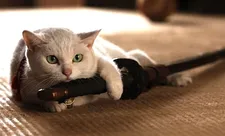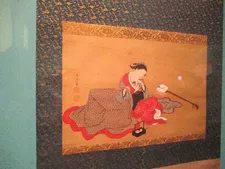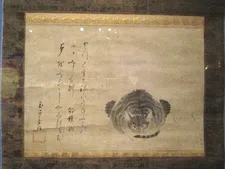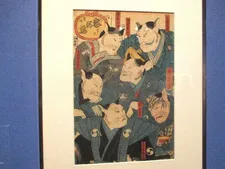 |
| Kazuki Kitamura with Tamanojo in Takeshi Watanabe and Yoshitaka Yamaguchi's Samurai Cat |
Two recently opened exhibitions in New York, Andrew Bolton and Wong Kar Wai's China: Through the Looking Glass at the Metropolitan Museum of Art and Yoko Ono: One Woman Show, 1960-1971 at The Museum of Modern Art, curated by Christophe Cherix and Klaus Biesenbach, have richly integrated film to magnify the experience, giving broader context to the work.
A sold-out special screening of Takeshi Watanabe and Yoshitaka Yamaguchi's Samurai Cat (Neko zamurai), which was shown in 2014 at the JAPAN CUTS Film Festival, was held last night in celebration of the second half of Japan Society's must-see Life Of Cats: Selections From The Hiraki Ukiyo-e Collection, closing this week.
 |
| Tamanojo, Samurai Cat, knows how to use what Paddington calls, "the hard stare." |
Samurai Cat is a wildly entertaining warrior story about two clans at battle with each other for 30 years because one family loves cats, the other dogs. Kyutaro Madarame (Kazuki Kitamura), is a once famous Samurai who is now living suspended in exile from his wife and daughter. He is offered much needed money by a gang to kill the rival family's white cat. The fluffy green-eyed little darling is named Tamanojo and knows how to use what Paddington calls, "the hard stare." Tama is the unrivaled star of the movie.
Much of the film's perspective is from inside Kyutaro's head, told in voiceover narration. It is a pure pleasure to watch how he is won over by Tama's very authentic feline charms. No gimmick is necessary when you get to watch the subtle cat mood changes, from demanding ennui to playful maniac and back to sleepy adorableness and picky eating habits. Warriors, honour codes and little animals complement each other well. Alain Delon as hitman Jef Costello in Jean-Pierre Melville's masterpiece Le Samouraï is unimaginable without the bird cage in his bare apartment.
 |
| Beauty With A Kitten hanging scroll on silk, ca. 1716-36 - Nishikawa Sukenobu Photo: Anne-Katrin Titze |
The thugs in Neko Samurai who ask silly questions such as "which do you prefer, dogs or cats?" get what they deserve in the end. "Is he an idiot?", we hear Kyutaro thinking. The big showdown comes as a kind of Japanese High Noon with swords and a sleeping cat. The movie is aware of its own silliness and truth. Effectively pacifist with a few stabs at Kafka, it reinforces things we shouldn't forget. "She is my family, too," the Samurai knows and everybody is aware who the song "I'm So Great" playing over the end credits is referring to.
Peace is restored in the galaxy and the audience happily cascaded into the Life Of Cats gallery space. The exhibition's second rotation, displaying 45 fresh ukiyo-e woodblock prints alongside paintings, scrolls and sculptures, was open after the screening to stroll through. Tamanojo inspired a specialty sake cocktail for the evening and the celebration continued late into the balmy May night.
Curated by Miwako Tezuka, the exhibition begins with the famous depiction of the 11th-century classic, The Tale of Genji by Lady Murasaki Shikibu, illustrated by Utagawa Kunisada, in woodblock prints. Anthropomorphised cats can be a very specific link to actors of the day. "In Utagawa Yoshiiku’s The Story of Otomi and Yosaburo (1860), six cats are shown gesturing and emoting. They are actually famous Kabuki actors whose features the artist has slyly captured under stage make up, cat ears, and whiskers. Members of the theater-going public of the day would have relished identifying each performer."
 |
| Meditating Cat With Kyoka Poem hanging scroll, ink on paper, late 17th Century - Hozobo Shinkai Photo: Anne-Katrin Titze |
If the tigers and lions in Japanese art of the Edo-period remind you of your pet, you could be on the right track: "Because lions and tigers are not native to Japan, some Edo-period artists began to look to house cats as handy models for the exotic predators. A visitor to Japan Society who closely examines the woodblock entitled Watonai Subduing a Tiger (ca. 1780-90) will see that its creator, Katsukawa Shun’ei, has given the tiger who attacks the legendary hero Watonai the slit pupils of a domestic cat. Edo-period artists continued to morph cats into lions and tigers until the influence of Western art became strong in the late 1800s."
The last section is devoted to toy pictures, called Omocha-e, popular from the mid 1600s to the late 1800s, "created to teach children to read, memorise, and count, as well as to convey lessons about morality and social conduct… Japan Society Gallery has tapped to present 12 rarely seen prints, including Utagawa Yoshifuji’s Popular Hotspring Spa [of Cats] (1880), where cats enact a cross section of daily activities, from bathing, to daintily taking tea, to selling items on the street."
 |
| Act 7 Modern Parody of Chushingura woodblock print, 1860 - Utagawa Yoshiiku Photo: Anne-Katrin Titze |
Sebastian Masuda's nine-foot tall Hello Kitty inspired Time After Time Capsule sculpture is the first to greet you at Dag Hammarskjold Plaza's Katharine Hepburn Garden, across from the Japan Society, at the kitty-corner, to be precise. The project began at last year's Art Basel Miami and will continue around the world after its stay here until September 13. After Miami, New York, Amsterdam and future cities under consideration, "all sculptures will be united at the 2020 Tokyo Olympics, bringing together the contained memories from all the participating cities."
Tamanojo challenges Lil Bub for the title of most adorable Neko.
In 2000, Japan Society organized YES YOKO ONO, which ran from October, 2000 to January 14, 2001. The exhibition traveled to the Walker Art Center, Minneapolis, Minnesota - Comtemporary Arts Museum, Houston, Texas - MIT (List Visual Arts Center), Cambridge, Massachusetts, Art Gallery of Ontario, Toronto, Canada - San Francisco Museum of Modern Art, and the Museum of Comtemporary Art, North Miami, Florida.
Life Of Cats: Selections From The Hiraki Ukiyo-e Collection runs till June 7, 2015 at Japan Society, 333 East 47th Street, New York.





















